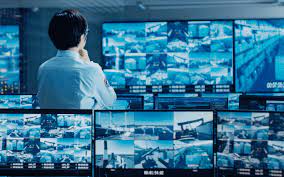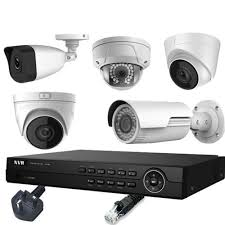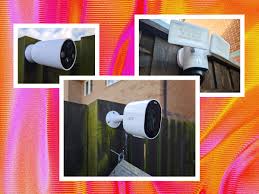Surveillance systems play a crucial role in enhancing security and monitoring activities in various settings, ranging from homes and businesses to public spaces and government facilities. These systems utilize advanced technology to capture, record, and analyze video footage for the purpose of surveillance and security management.
One of the key components of a surveillance system is the Closed Circuit Television (CCTV) camera, which is strategically placed to monitor specific areas in real-time. These cameras come in various types, including dome cameras, bullet cameras, and PTZ (Pan-Tilt-Zoom) cameras, each serving different surveillance needs.
Modern surveillance systems are equipped with features such as motion detection, night vision, remote access, and high-definition video recording capabilities. These features enable users to monitor their premises efficiently and effectively, even in low-light conditions or from remote locations.
In addition to CCTV cameras, surveillance systems often include components like digital video recorders (DVRs) or network video recorders (NVRs) for storing and managing recorded footage. These devices allow users to review past events, retrieve specific footage for investigations, and ensure continuous monitoring of their premises.
With the advancement of technology, surveillance systems now offer integration with other security solutions such as access control systems, alarm systems, and smart home automation devices. This integration enables users to create a comprehensive security ecosystem that enhances overall safety and protection.
Overall, surveillance systems have become indispensable tools for maintaining security and peace of mind in today’s fast-paced world. Whether used for deterring criminal activities, monitoring employee behavior in workplaces, or ensuring the safety of public spaces, these systems provide an extra layer of protection that is essential in today’s society.
Seven Key Advantages of Implementing a Surveillance System for Enhanced Security and Safety
- Enhances security and deters criminal activities.
- Provides real-time monitoring of premises and assets.
- Aids in investigations by capturing critical footage of incidents.
- Increases safety for residents, employees, and visitors.
- Helps prevent theft, vandalism, and unauthorized access.
- Offers peace of mind through continuous surveillance and alerts.
- Can be integrated with other security systems for comprehensive protection.
Seven Downsides of Surveillance Systems: Privacy, Misuse, Costs, and Security Risks
- Privacy concerns due to constant monitoring of individuals’ activities.
- Potential misuse of surveillance footage for unauthorized purposes.
- High initial cost of installing a comprehensive surveillance system.
- Maintenance and upkeep expenses can be significant over time.
- Risk of system malfunctions or technical failures leading to gaps in security coverage.
- Legal issues regarding the use of surveillance footage as evidence in court.
- Potential for cyber threats and hacking vulnerabilities in network-connected surveillance systems.
Enhances security and deters criminal activities.
Surveillance systems play a pivotal role in enhancing security by acting as a deterrent to criminal activities. The presence of visible cameras and monitoring equipment serves as a warning to potential wrongdoers, dissuading them from engaging in unlawful behavior. The knowledge that their actions are being recorded and monitored acts as a powerful preventive measure, reducing the likelihood of crimes such as theft, vandalism, and trespassing. In this way, surveillance systems not only help in detecting and investigating incidents but also proactively contribute to creating a safer environment for individuals and properties.
Provides real-time monitoring of premises and assets.
One of the key advantages of surveillance systems is their ability to provide real-time monitoring of premises and assets. By utilizing CCTV cameras and advanced monitoring technology, surveillance systems offer continuous surveillance of designated areas, allowing users to keep a watchful eye on their surroundings at all times. This real-time monitoring capability enables prompt detection of any suspicious activities or security breaches, facilitating immediate response and intervention to protect valuable assets and ensure the safety and security of the premises.
Aids in investigations by capturing critical footage of incidents.
Surveillance systems serve as invaluable tools in aiding investigations by capturing critical footage of incidents. The high-quality video recordings obtained from CCTV cameras provide crucial evidence that can help law enforcement agencies, security personnel, and businesses to identify suspects, analyze events, and gather information for resolving criminal activities or security breaches. This visual documentation not only helps in understanding the sequence of events but also plays a significant role in ensuring justice and holding accountable those responsible for unlawful acts. The ability of surveillance systems to capture real-time footage of incidents greatly enhances the efficiency and effectiveness of investigations, ultimately contributing to maintaining a safer and more secure environment for all.
Increases safety for residents, employees, and visitors.
One significant advantage of surveillance systems is their ability to enhance safety for residents, employees, and visitors alike. By monitoring activities in real-time and recording footage, surveillance systems act as a deterrent to potential threats and criminal activities. The presence of cameras can create a sense of security and accountability, discouraging unwanted behavior and promoting a safer environment for all individuals within the premises. In the event of an incident, recorded footage can provide valuable evidence for investigations and help authorities take appropriate actions swiftly, thereby ensuring the well-being and safety of everyone involved.
Helps prevent theft, vandalism, and unauthorized access.
Surveillance systems are instrumental in preventing theft, vandalism, and unauthorized access by serving as a deterrent and providing evidence for investigation. The presence of CCTV cameras and monitoring equipment acts as a powerful deterrent to potential intruders or vandals, dissuading them from committing crimes knowing they are being watched. In the event of an incident, recorded footage from surveillance systems can be used to identify perpetrators, gather evidence, and aid in prosecuting offenders. This proactive approach to security not only protects property and assets but also contributes to creating a safer environment for individuals and businesses alike.
Offers peace of mind through continuous surveillance and alerts.
Continuous surveillance and alerts provided by surveillance systems offer a valuable sense of peace of mind to users. Knowing that their premises are being monitored around the clock, and receiving instant alerts in case of any suspicious activity or security breaches, allows individuals to feel secure and confident in the safety of their homes, businesses, or public spaces. This proactive approach to security not only deters potential threats but also ensures a swift response to any incidents, ultimately contributing to a heightened sense of safety and well-being for all stakeholders involved.
Can be integrated with other security systems for comprehensive protection.
The key advantage of surveillance systems is their ability to seamlessly integrate with other security solutions, allowing for a comprehensive approach to protection. By combining surveillance cameras with access control systems, alarm systems, and smart home automation devices, users can create a sophisticated security ecosystem that offers enhanced monitoring and control capabilities. This integration ensures that all components work together harmoniously to provide maximum security coverage, real-time alerts, and streamlined management of security protocols. Ultimately, the ability to integrate surveillance systems with other security systems significantly enhances overall protection and peace of mind for users.
Privacy concerns due to constant monitoring of individuals’ activities.
One significant con of surveillance systems is the heightened privacy concerns arising from the constant monitoring of individuals’ activities. The pervasive nature of surveillance technology raises questions about the extent to which individuals’ privacy is being compromised in both public and private spaces. Continuous monitoring through CCTV cameras and other surveillance tools can lead to a sense of intrusion and unease among individuals, as their every move and action may be under scrutiny. This erosion of privacy can have far-reaching implications on personal freedom, autonomy, and the right to conduct activities without fear of constant surveillance.
Potential misuse of surveillance footage for unauthorized purposes.
The potential misuse of surveillance footage for unauthorized purposes poses a significant con of surveillance systems. In some cases, individuals or organizations may exploit access to recorded video footage for unethical or illegal activities, such as invasion of privacy, blackmail, or manipulation of information. Unauthorized use of surveillance footage can lead to breaches of confidentiality and trust, undermining the intended purpose of security and protection. This misuse highlights the importance of implementing strict access controls, data encryption, and ethical guidelines to prevent unauthorized access and ensure the responsible use of surveillance systems.
High initial cost of installing a comprehensive surveillance system.
One significant drawback of implementing a comprehensive surveillance system is the high initial cost associated with installation. The expenses involved in purchasing cameras, recording equipment, monitoring software, and other necessary components can pose a financial challenge for individuals or businesses looking to enhance their security measures. The upfront investment required for a sophisticated surveillance system may deter some potential users from fully embracing this technology, especially those operating on tight budgets or limited resources. Despite the long-term benefits of improved security and peace of mind, the high initial cost remains a notable con that must be carefully considered and planned for when deciding to implement a comprehensive surveillance system.
Maintenance and upkeep expenses can be significant over time.
One significant drawback of surveillance systems is the ongoing maintenance and upkeep expenses that can accumulate over time. The initial cost of installing a surveillance system may be manageable, but over the years, expenses related to repairs, upgrades, and software updates can add up significantly. Regular maintenance is essential to ensure that the system functions optimally and continues to provide reliable security monitoring. Additionally, as technology evolves rapidly, older surveillance equipment may become obsolete, necessitating costly replacements to keep up with the latest advancements in the field. Thus, the financial burden of maintaining a surveillance system can be a considerable con that users need to factor in when investing in such security solutions.
Risk of system malfunctions or technical failures leading to gaps in security coverage.
One significant con of surveillance systems is the risk of system malfunctions or technical failures, which can result in gaps in security coverage. In the event of a malfunction, such as a camera outage or recording failure, certain areas may go unmonitored, leaving vulnerabilities that could be exploited by intruders or unauthorized individuals. These gaps in security coverage can compromise the overall effectiveness of the surveillance system and potentially undermine its intended purpose of providing continuous monitoring and protection.
Legal issues regarding the use of surveillance footage as evidence in court.
Legal issues surrounding the use of surveillance footage as evidence in court can present a significant con of surveillance systems. While surveillance footage can be a valuable tool for investigating and prosecuting crimes, concerns may arise regarding the authenticity, admissibility, and privacy implications of such evidence. Issues such as chain of custody, tampering with footage, and compliance with privacy laws can cast doubt on the reliability and integrity of surveillance evidence in legal proceedings. Additionally, questions may arise about the legality of obtaining surveillance footage without proper consent or warrants, raising ethical and constitutional concerns about individual rights to privacy and due process. As a result, navigating the complex legal landscape surrounding the use of surveillance footage in court cases requires careful consideration and adherence to legal protocols to ensure fair and just outcomes.
Potential for cyber threats and hacking vulnerabilities in network-connected surveillance systems.
The potential for cyber threats and hacking vulnerabilities in network-connected surveillance systems poses a significant con that cannot be ignored. As these systems rely on internet connectivity for remote access and data storage, they become susceptible to unauthorized access by malicious actors. Cybercriminals can exploit security loopholes in the network infrastructure, weak passwords, or outdated software to infiltrate the surveillance system, compromising sensitive video footage and exposing privacy concerns. The risk of data breaches and unauthorized surveillance highlights the importance of implementing robust cybersecurity measures to safeguard network-connected surveillance systems from cyber threats and protect the integrity of the information being captured and stored.




